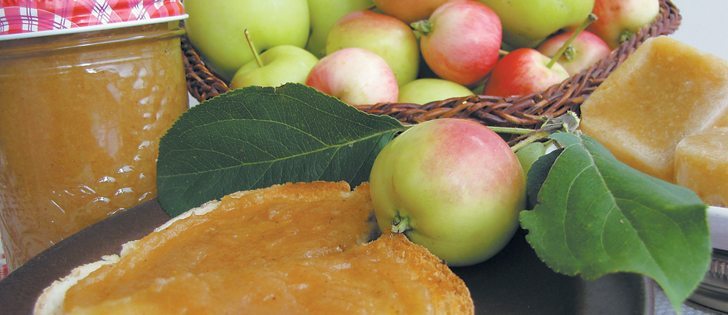Local apple trees are laden with ripening apples and crab-apples. Crabapples and small apples do well in prairie gardens, but the bounty is often left unused.
I like using Heyer apples and crab-apples to make juice, pies, jelly and applesauce. I have a food mill, canner and juicer to help process the apples.
Apples are a good source of insoluble and soluble fibre. The insoluble fibre provides bulk that helps cleanse and move food quickly through the intestinal tract, reducing the risk of colon cancer.
Read Also

Agri-business and farms front and centre for Alberta’s Open Farm Days
Open Farm Days continues to enjoy success in its 14th year running, as Alberta farms and agri-businesses were showcased to increase awareness on how food gets to the dinner plate.
Apple pectin is classified as soluble, fermentable and viscous fibre. Pectin helps reduce heart disease and atherosclerosis by preventing cholesterol buildup in the lining of the blood vessel walls. It can also limit sugar swings that are a factor in Type 2 diabetes.
Apples can help relieve both diarrhea and constipation. The fibre found in apples can absorb excess water from loose stools to slow the bowels down or it can pull water out of the colon to help relieve constipation.
Apples are low in calories and a good source of vitamin C.
Source: www.urbanext.illinois.edu.
MAKING APPLESAUCE
Applesauce is a versatile food that can be used as a first food for infants, added to baking to reduce the fat content or used for dessert.
To make applesauce, select sound fruit and wash thoroughly. A combination of apple varieties can be used, but the less tart apples will help sweeten the flavour.
Remove the stems and cut off the blossom ends and blemishes. Cut the apples in half through the core. If apple is large, cut into quarters.
Cutting through the core allows the pectin soluble fibre to release. Add one-half inch (1 cm) of water to the bottom of a stainless steel or enamel pot. Add the apple pieces and two tablespoons (30 mL) of lemon juice to prevent apple browning and cover the pot.
Cook on medium heat, stirring frequently to prevent scorching. When the apples begin to soften, use a potato masher to crush them. Once all are mushy, put the cooked apples through a food mill or press them through a coarse sieve to remove the core and skin. Preserve or freeze the apple pulp, use as unsweetened applesauce in recipes or sweeten to your taste and eat fresh.
If freezing applesauce for use in recipes, place one-half to one cup (125 to 250 mL) amounts in containers. For infant feeding, freeze unsweetened applesauce in an ice cube tray. Once frozen, remove the cubes and store in a sealed, labelled plastic bag in the freezer.
CANNING APPLESAUCE
- 8 c. apple pulp 2 L
- 1 – 2 c. sugar 250–500 mL
- ascorbic acid
- or Fruit Fresh
Taste the apple pulp to determine how tart it is. Measure the apple pulp into a large stainless steel or enamel pot and add sugar depending on tartness and desired sweetness. Bring to a boil. When preserving, use clean equipment that has been sterilized by immersing into boiling water for a few minutes prior to using.
Wash eight 250 mL mason jars and place on a rack in a boiling water canner. Cover the jars with water and heat to a simmer. Have a pan of hot water heating that will be used to heat the metal sealing lids.
Using a jar lifter, remove one of the hot jars from the water, drain the water from the jar and place on a clean plate. Put one of the sealing lids into the pan of hot water.
Place a jar funnel into the jar. Ladle the hot applesauce in, allowing one-quarter inch (.05 cm) of headspace in the jar.
Sprinkle ascorbic acid or Fruit Fresh on the top of applesauce to help prevent browning. Remove the funnel and place in the top of the next jar. Use a small plastic knife or other non-metallic utensil to remove air bubbles in the jar.
Wipe the rim of the jar with a damp paper towel to remove any stickiness. Centre the sealing lid onto the jar, apply a screw band and tighten the band until fingertip tight. Do not over tighten. Place jar in canner and repeat with the other jars until all have been filled. Add extra hot water to cover the jars by at least one inch (2 cm). Cover the canner and bring the water to a boil. Begin timing and process for 10 minutes.
Using a jar lifter, remove each jar without tipping and place on a folded towel on the counter. Allow to cool for 24 hours without being moved. Do not retighten the screw bands. Label and store jars in a cool place.
Adapted from Bernardin Guide to Home Preserving.
SPICED APPLE BUTTER
This jam-like butter is great served on toast or biscuits or as a side dish with pork. It can also be added to meat sandwiches as a condiment.
- 6 c. prepared apple pulp 1.5 L
- 2 – 3 c. sugar 500-750 mL
- 1 tsp. ground cloves 2 mL
- 1 tbsp. cinnamon 3 mL
- 1/2 tsp. allspice 2 mL
Measure pulp into a large stainless steel or enamel pot. Add sugar depending on tartness of apples and desired sweetness of the butter. Stir well to mix. On medium heat, bring to a full boil. Stir frequently to prevent scorching. Wear an oven mitt because the bubbling sauce can splash and burn. Boil until thick, then add spices and mix.
Prepare, fill and process seven 250 mL jars as described in the Canning applesauce recipe.
Adapted from Using Saskatchewan Crabapples, University of Saskatchewan.
Many uses for applesauce
- Serve applesauce or apple butter as a condiment with grilled pork chops or roasted pork tenderloin.
- Reduce the fat in baked goods by replacing half of the fat with an equal amount of applesauce. Replacing the fat with applesauce gives a rubbery texture to the baked goods.
- The substitution doesn’t work as well in yeast breads, but is delicious in coffee cake, brownies, muffins or cookies.
- Add applesauce to hot porridge, top with brown sugar, raisins, nuts and milk for a hearty, healthy breakfast.
- Add applesauce to Greek yogurt, ricotta or cottage cheese, sprinkle with nutmeg for a snack or top with granola for a parfait dessert.
- Purée cream cheese and applesauce for a vegetable or fruit dip.
- Serve warm applesauce with pancakes or waffles. Also a traditional favourite with potato pancakes.
- Serve applesauce with warm gingerbread cake for dessert or with coffee.
- Use applesauce to replace jam in a peanut butter sandwich.
Betty Ann Deobald is a home economist from Rosetown, Sask., and a member of Team Resources. Contact: team@producer.com.
















